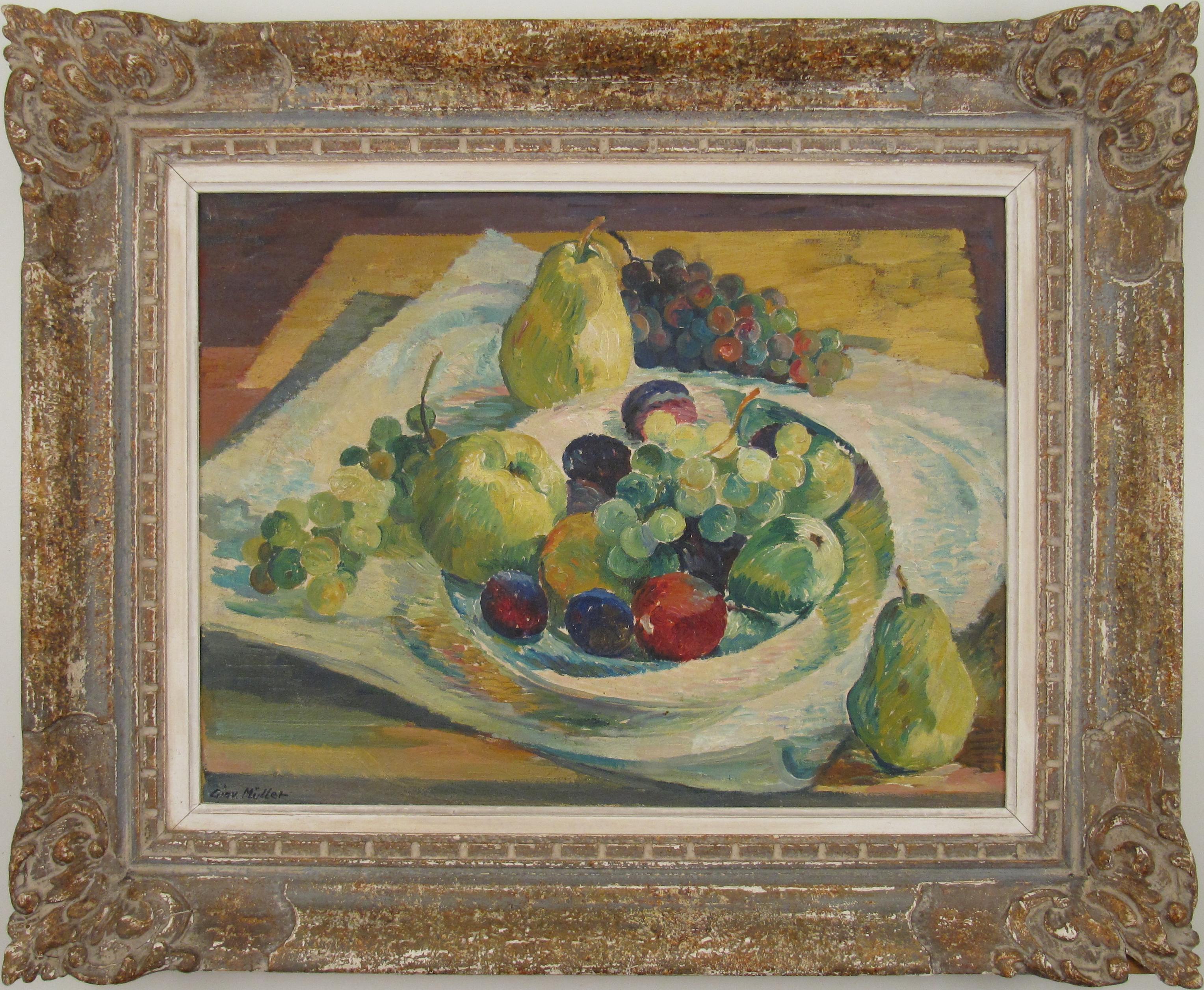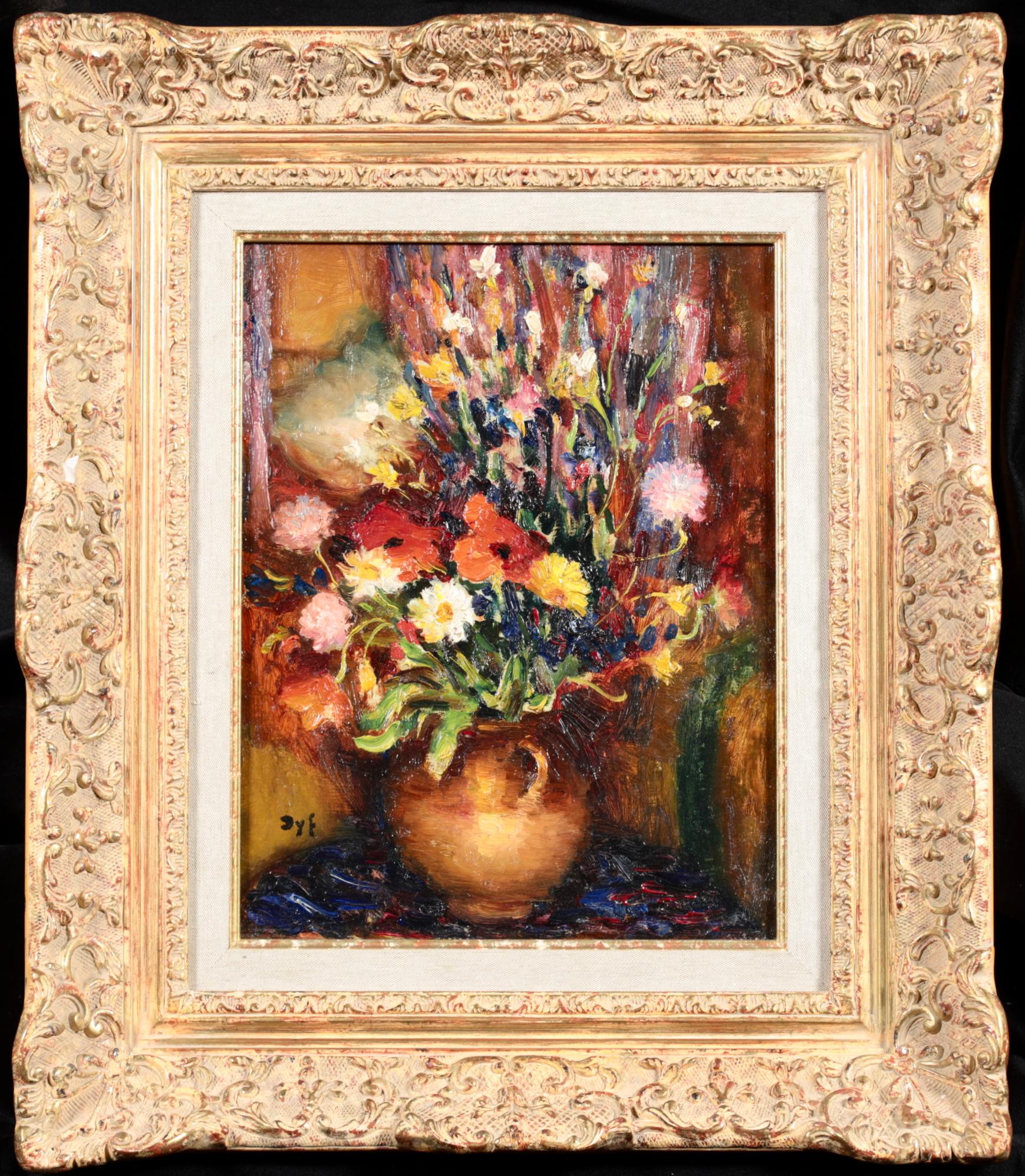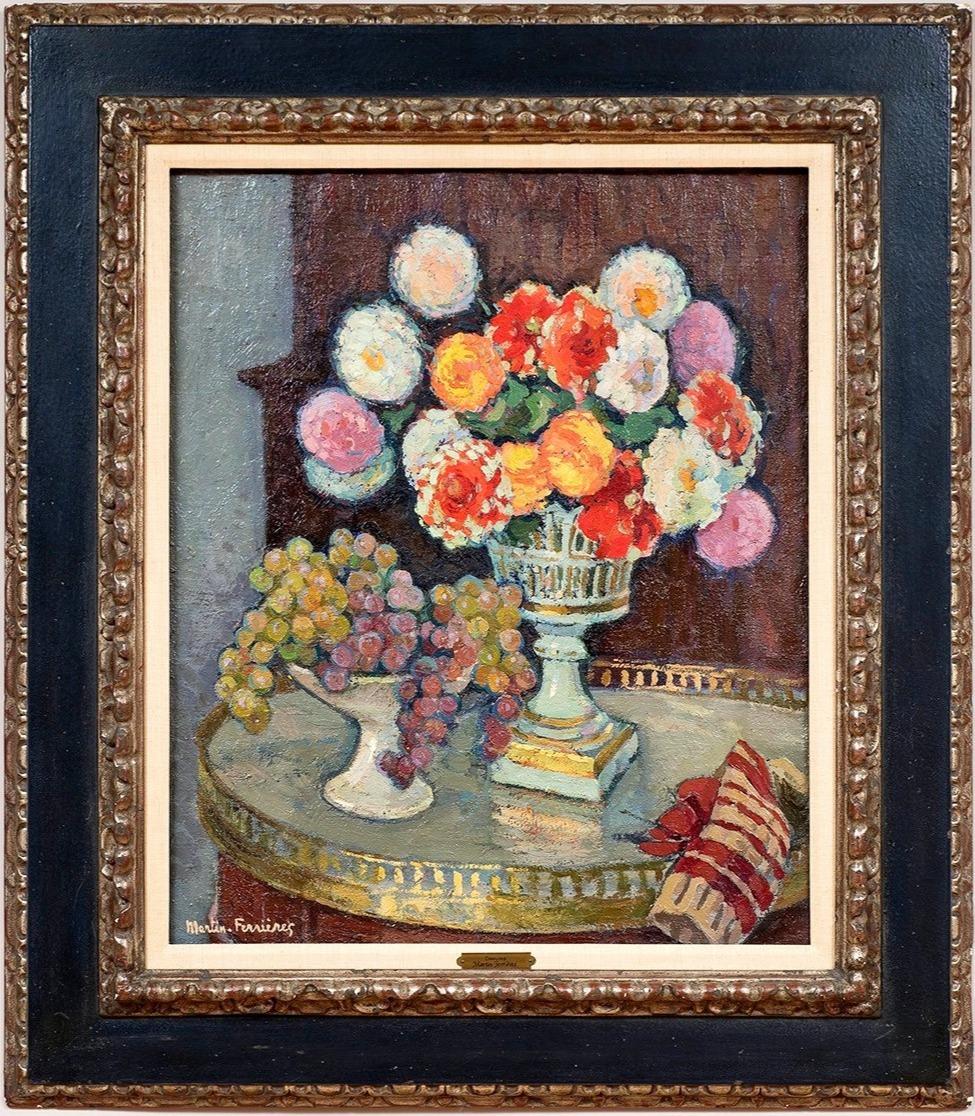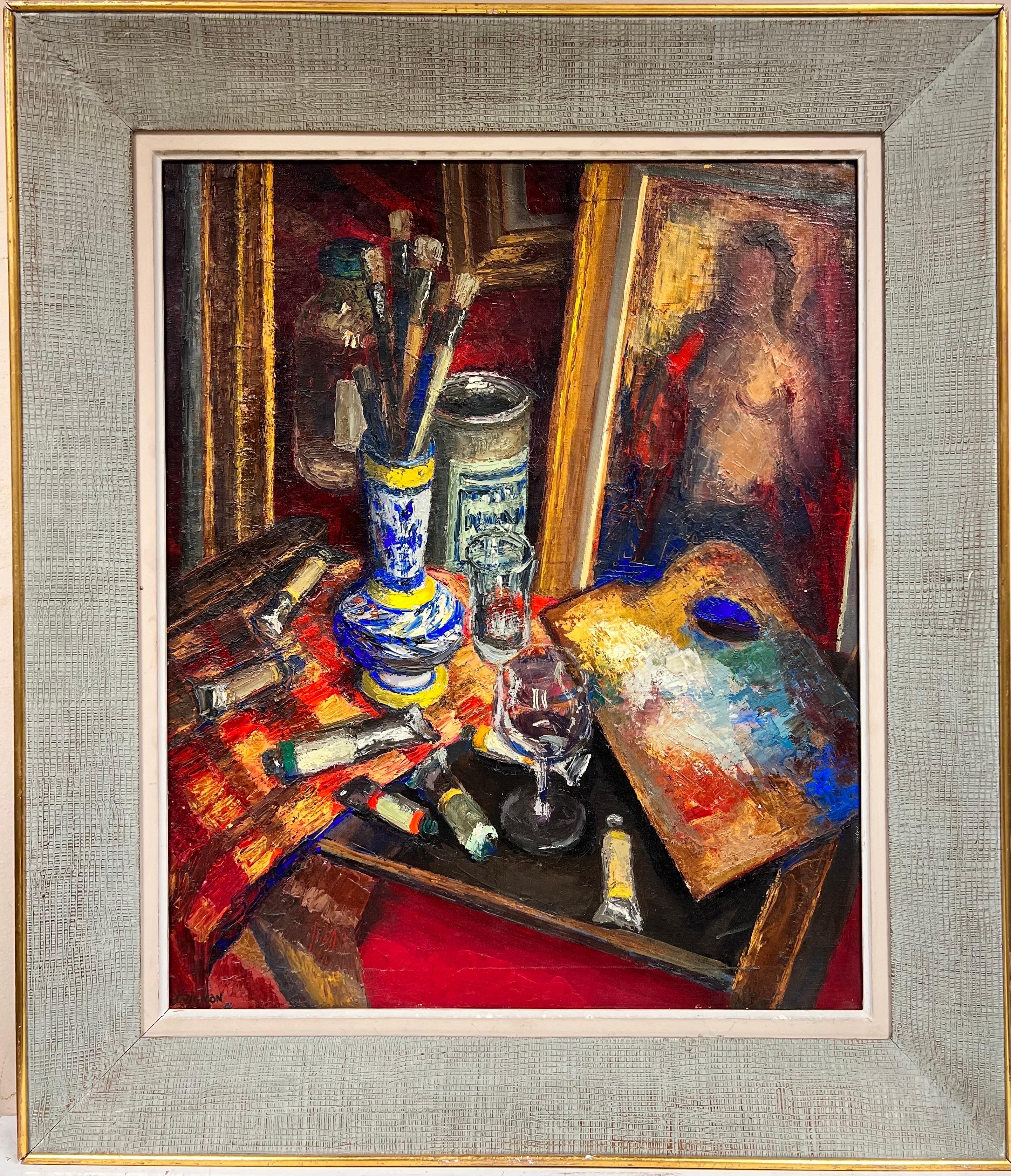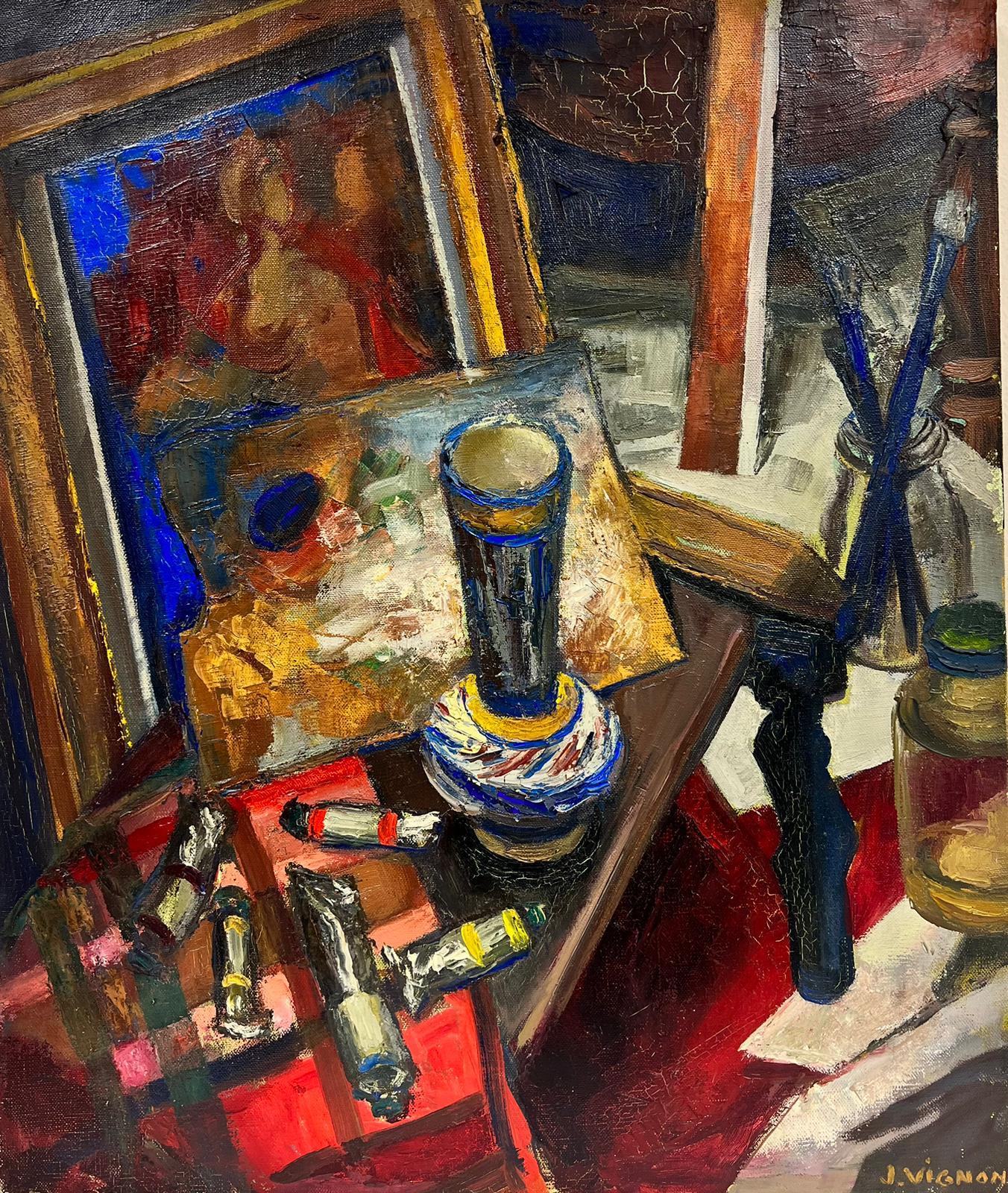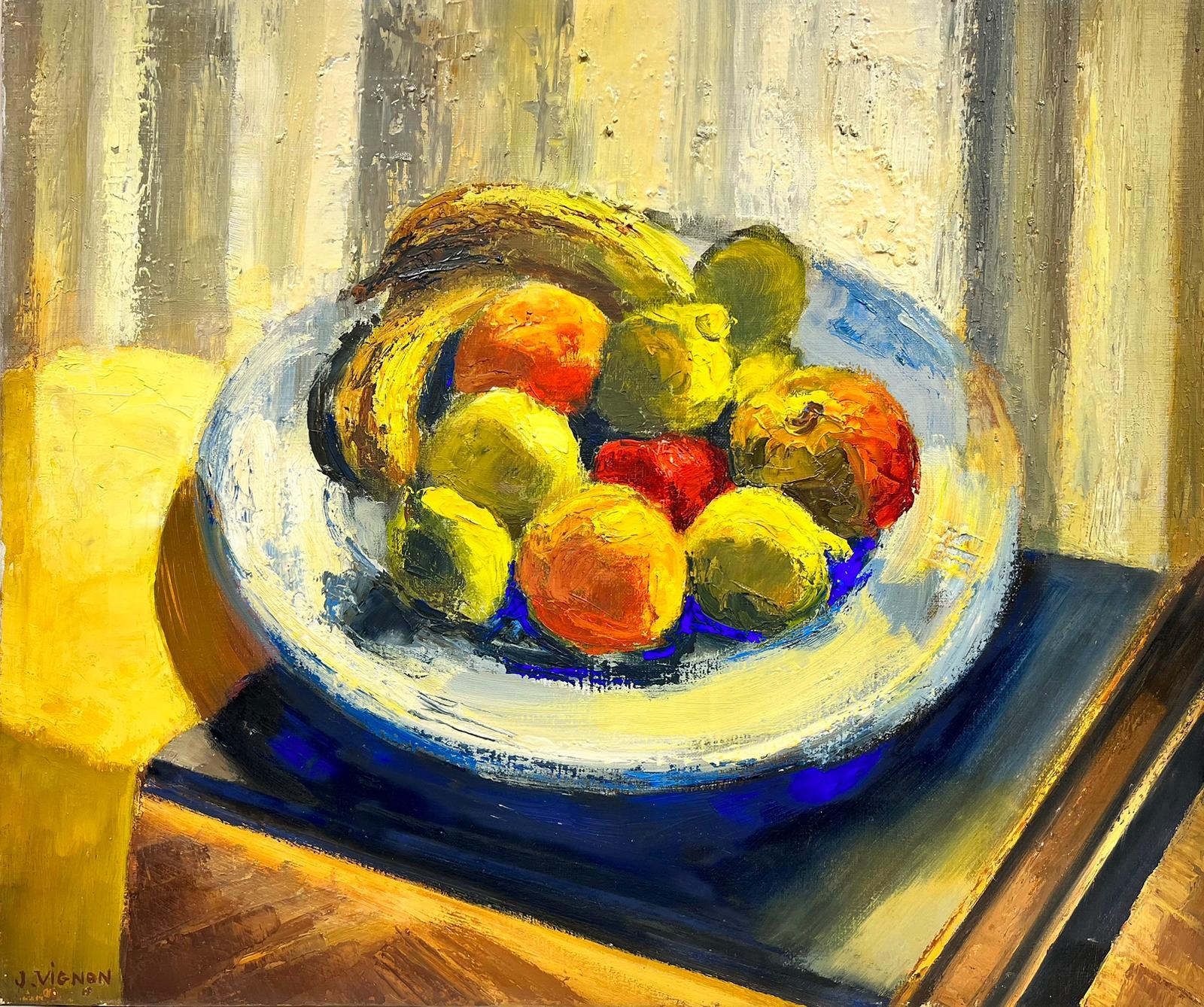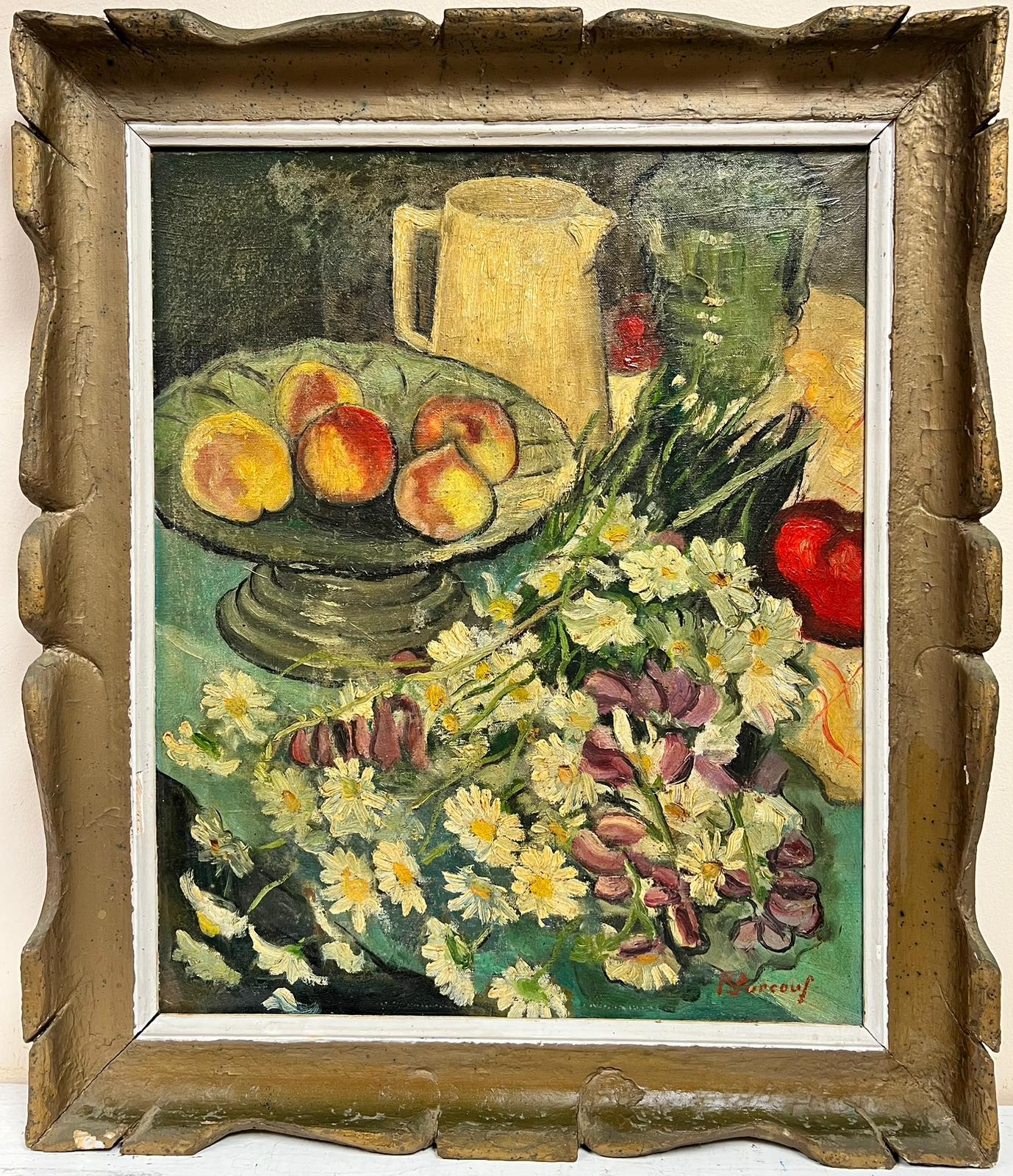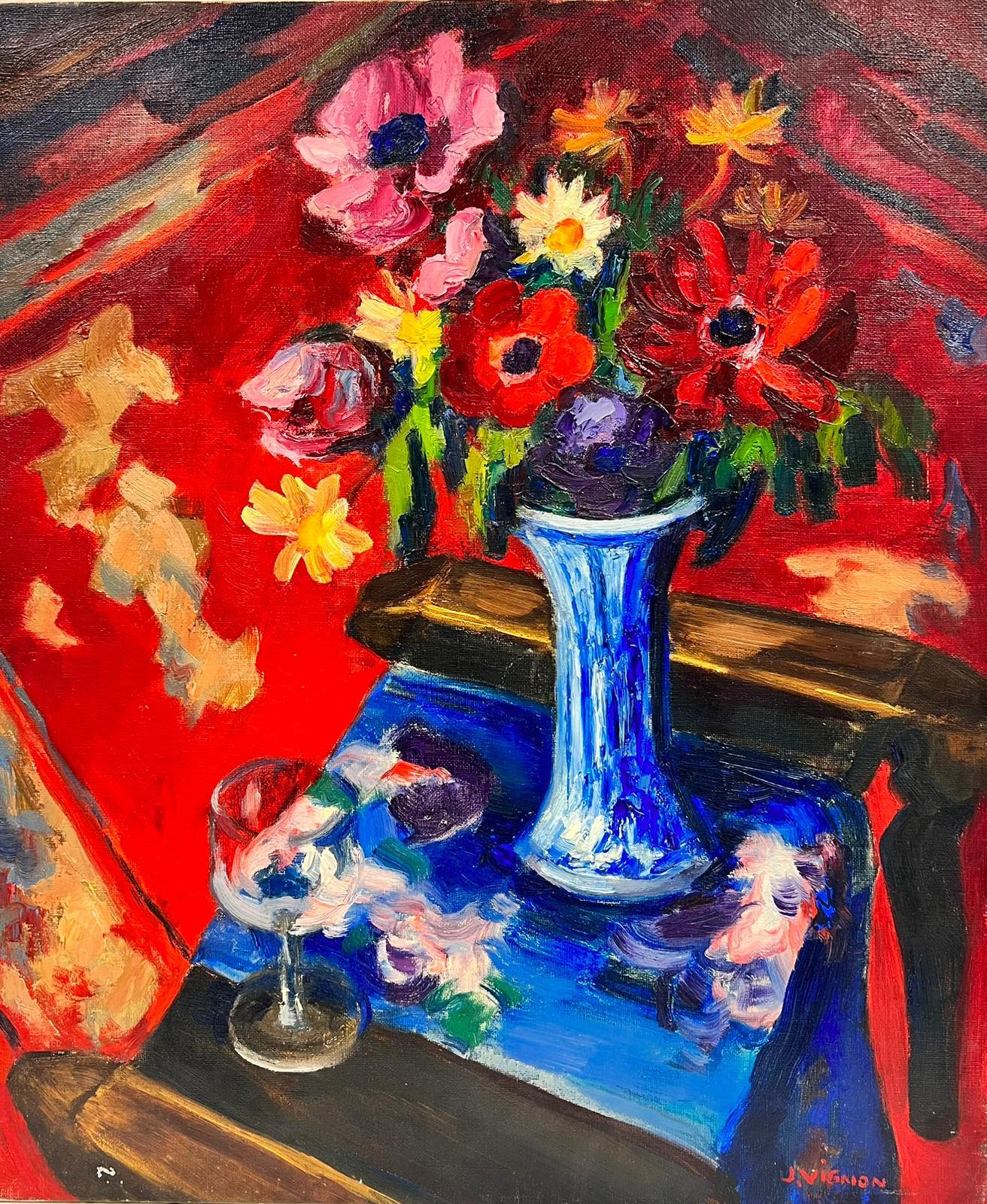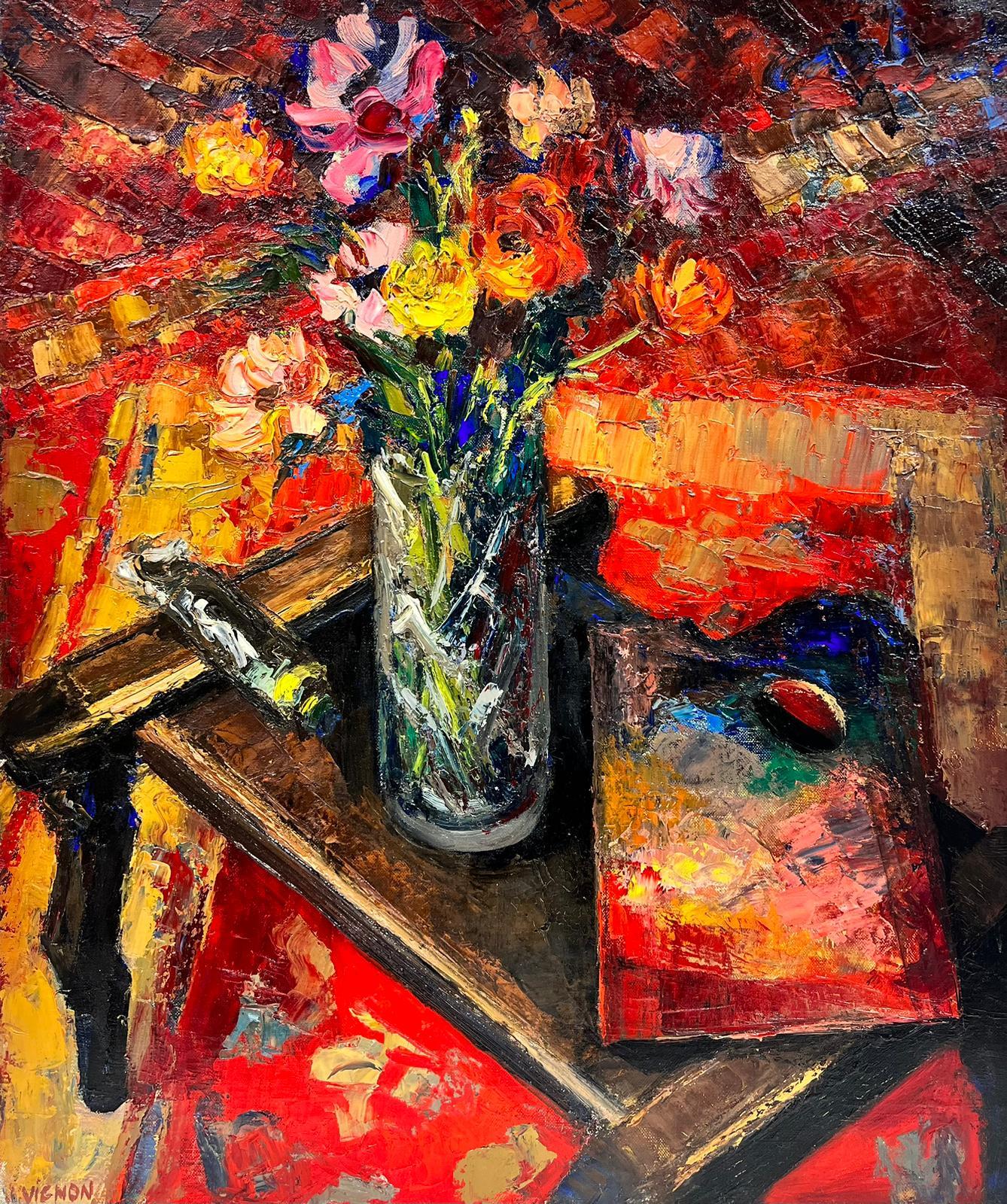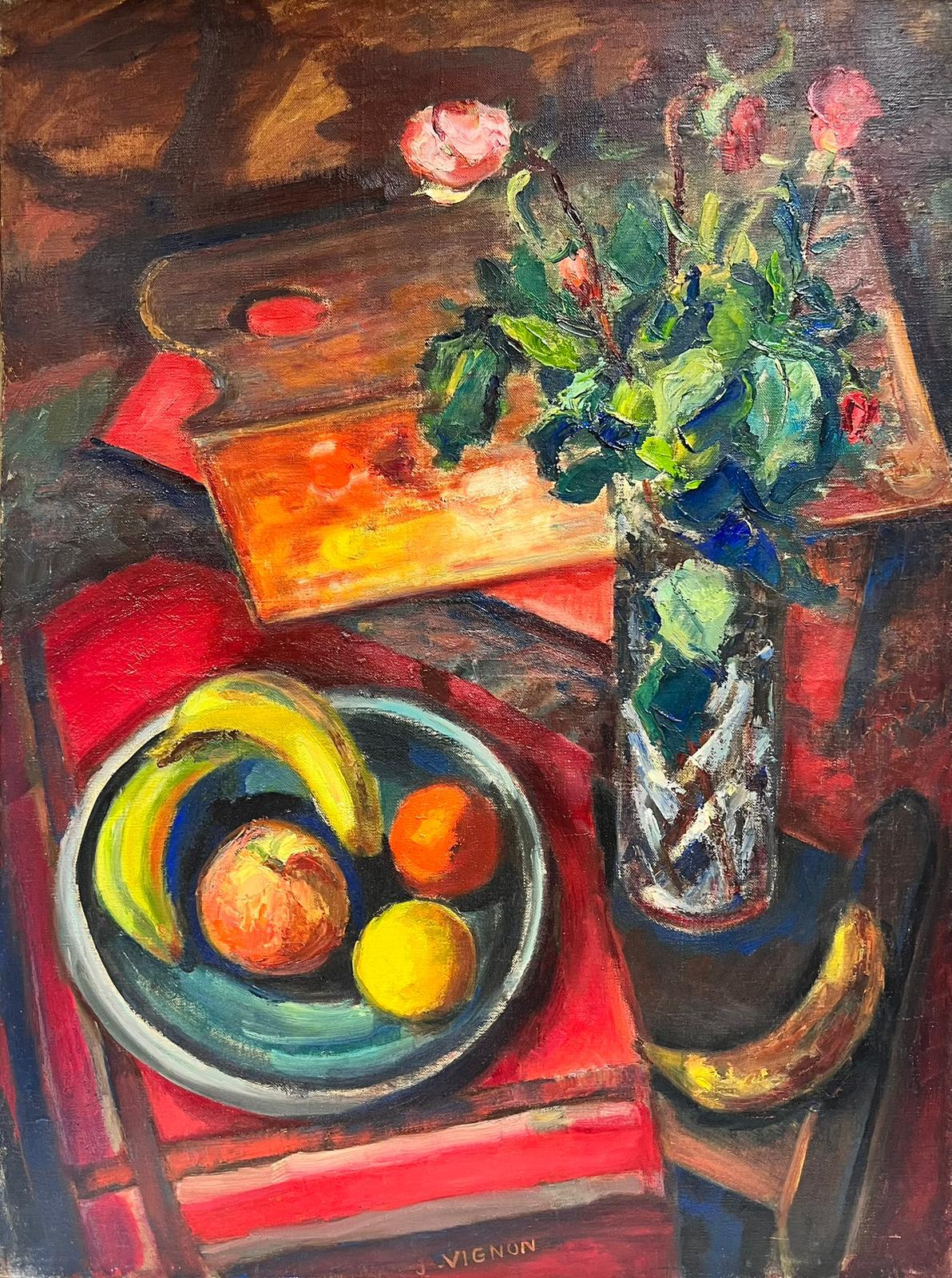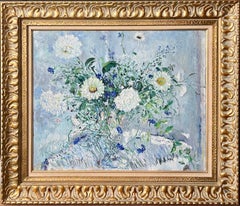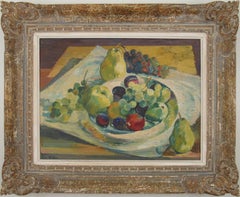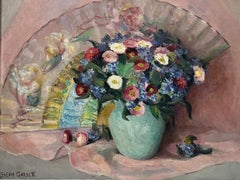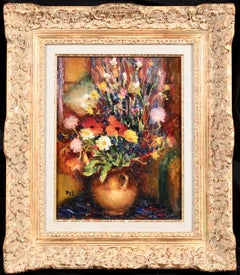
Large Folk Art Modernist Floral Bouquet Oil Painting Flowers in Vase Gilt Frame
View Similar Items
Want more images or videos?
Request additional images or videos from the seller
1 of 16
Samuel RothbortLarge Folk Art Modernist Floral Bouquet Oil Painting Flowers in Vase Gilt Framec.1950's
c.1950's
About the Item
- Creator:Samuel Rothbort (1882-1971, American)
- Creation Year:c.1950's
- Dimensions:Height: 42 in (106.68 cm)Width: 37 in (93.98 cm)
- Medium:
- Movement & Style:
- Period:
- Condition:good. painting has been relined. minor wear. minor loss to side edges of frame.
- Gallery Location:Surfside, FL
- Reference Number:1stDibs: LU3825745812
About the Seller
4.9
Platinum Seller
These expertly vetted sellers are 1stDibs' most experienced sellers and are rated highest by our customers.
Established in 1995
1stDibs seller since 2014
1,546 sales on 1stDibs
Typical response time: 1 hour
More From This SellerView All
- Japanese Fauvist Colorful Oil Painting Chinese Ceramic Jars with Fan and AppleLocated in Surfside, FLYoshio Aoyama (Japanese, 1894-1996) "Nature Morte". Oil on canvas. 1981. Signed 'Aoyama' (upper left). Signed and titled 'Nature Morte' verso. 15" x 18" ...Category
1980s Fauvist Interior Paintings
MaterialsCanvas, Oil
- French Post Impressionist Oil Painting Floral Roses, Vase Gaston Sebire FlowersBy Gaston SebireLocated in Surfside, FLLes Roses Mixed bouquet of roses, Oil painting PROVENANCE: Purchased at Findlay Galleries in Chicago, Illinois late 1960’s bears their label verso and has their original price tag ...Category
1960s Post-Impressionist Still-life Paintings
MaterialsCanvas, Oil
- Bold Folk Art Modernist Floral Bouquet Oil Painting Flowers in Vase Gilt FrameBy Samuel RothbortLocated in Surfside, FLSAMUEL ROTHBORT (Russian-American, 1882-1971), still life with wild flowers, oil on canvas board, signed lower left. Framed 25.5 X 30, board 18.5 X 23 Samuel Rothbort (Russian American Jewish folk artist 1881-1972) was born in the small town, shtetl of Wolkovisk in the Russian Woodlands.During his youth he worked as a cantor and traveled to various towns and villages, gaining many impressions of life in that era. Poverty as well as the political unrest of the times led to his immigration to America in 1904. Upon arrival in America, Samuel Rothbort worked as a laborer and muralist eventually giving that up to become a watchman of newly built homes. While on duty he began molding figures in clay and upon the advice and encouragement of his employer and colleagues he began to take his artistic talents more seriously and pursued this endeavor. Rothbort therefore began doing free-hand painting, murals on walls and ceilings for private homes and commercial establishments. In 1909 he met and married Rose Kravitz, which marked the start of his career as an artist. Well known for his scenes of New York City life, executed in heavy impasto. Rothbort exhibited from the 1920s-60s, at the Salons of America, Pratt Institute, Brooklyn Museum, and a gallery at Rockefeller Center; however, he refused to sell his work, and in 1948, opened the Rothbort Home Museum of Direct Art, in his studio-home. Samuel Rothbort was a self taught, naive, outsider artist painting every subject in his own folk art impressionistic style. His artistic range was broad and he never stopped creating. He was fascinated with nature and his works are filled with his delightful perceptions of his surroundings. Rothbort worked in oil, watercolor, and pen & ink. In the years of the depression there was little money, Rothbort could not afford paint or canvas. It was there that he began carving wood and stone using found materials like driftwood, rails, and old fence posts. Rothbort entered the art world and spent much of his life in pursuit of modernist painting and sculpture. He was a member the Society of Independent artists, the Salons of America, the People's Art Guild, and the Brooklyn Society of Artists. During the 1920's and early 1930's , Samuel Rothbort was regularly represented in exhibitions organized by The Brooklyn Museum of Art. Through the 1930's , Rothbort exhibited his watercolors and sculptures at Grant Studios in Brooklyn. In 1940, he began a 28 year relationship with the Barzansky Gallery on Madison Avenue in New York City exhibiting oils, watercolors, and sculpture in individual and group shows. From 1915 through the 1960's, he was represented by many commercial galleries. Hamilton Easter Field, artist, publisher and founder of the Brooklyn Society of Artists was an early supporter of Rothbort's artwork and helped further his career. Rothbort received much recognition for his naive folk art paintings...Category
20th Century Post-Impressionist Interior Paintings
MaterialsOil
- Expressionist School of Paris Oil Painting Still Life with Pear and FlowersBy Michel De GallardLocated in Surfside, FLMichel de Gallard (1921-2007) was a French painter. He is considered a member of the School of Paris and La Ruche and is associated with French artists Andre Minaux, Bernard Buffet ...Category
Mid-20th Century Expressionist Interior Paintings
MaterialsCanvas, Oil
- Israeli Folk Art Oil Painting Pomegranates Naive Style Still Life Hedva YardeniLocated in Surfside, FLFramed 29.5 X 37.25 sight 28.5 X 36.25 Hedva Yardeni was born in 1969 in Jerusalem to a traditional jewish family. She grew up in Jerusalem, Israel. During 2004 yardeni settled in los angeles, on this time Yardeni's work was based on images, landscapes and jewish symbols taken from her childhood in Jerusalem. The dominant motif in her work is the pomegranate. In the jewish – Israeli tradition, a myriad of symbolic meanings has been ascribed to the pomegranate. This humble fruit signifies the land of israel and the revival of the jewish people. It is the symbol of the land's wealth and prosperity. Yardeni returned to Israel in 2005, settling in the galilee. She rediscovered the exquisite beauty of her home land and let the full expression of her deep love to Jerusalem from her soul and onto the canvas.Her recent work is full of light and joy reflect an inner spirit that is always reaching towards the Almighty. They are more abstract, pure and radiant with light. Her work has a naive, whimsical, folk art quality to it. Yardeni grew up in Jerusalem and completed her BA in art at Kay academy Beer Sheva, and my MA at Schechter Institute of jewish Studies...Category
21st Century and Contemporary Folk Art Interior Paintings
MaterialsCanvas, Oil
- 1925 Viennese Oil Painting Interior Still Life with Porcelain Vase, Tapestry RugLocated in Surfside, FLFramed 21.2 X 25.5 Unframed 17 X 21 Signed and dated 1920. Nina Karasek (Joële) born 1883 Kuttenberg, Czech Lands, Austro-Hungarian Empire, died in 1952 (I have also seen the date recorded as 1933) Vienna, Austria. Nina Karasek was an Austrian Impressionist & Modern artist who was born in 1883. Her work was featured in exhibitions at the Es Baluard, Museum of Modern & Contemporary Art and the Bildraum Bodensee. Little is known of Nina Karasek's life. She was born in 1883 in Kuttenberg (Kutná Hora) in Bohemia, studied art at the Kunstschule für Frauen und Mädchen (Art School for Women and Girls) in Vienna, Austria, under Adalbert Seligmann and Tina Blau. She studied at the Frauenakademie in Vienna and Munich. In the 1920's she worked first as a landscape painter and an illustrator, later turning toward symbolism, painting mystical subjects after her interest in spiritualism. Her conventional works were shown at various exhibitions. At the age of 44, while she was copying a work by Rembrandt in an Italian museum, she fell into an altered state of consciousness. Rembrandt appeared to her, took possession of her arm, and immediately her hand started to draw something quite different from what she had intended. From then on, for the rest of her life Nina Karasek was in “supernatural” contact with a series of great masters like Rembrandt, Albrecht Dürer, Goya, Raphael, Leonardo da Vinci, Gustav Klimt and others. Under their guidance and inspiration, she drew and painted works "in the style" of the masters. But very soon her works became stylistically more and more unrestricted and Symbolist, showing an enormous range of creative expression, ranging from symbolic and allegorical motifs to bewildering images with a fantastic arsenal of figures and private characters, signs, and symbols, and to frantic, gestural sketches and abstract compositions. From then on, she often signed her works with her esoteric “primordial name” Joële. (Nina Karasik-Joel) Almost everything we know about her life was from what she noted on the reverse of her drawings: sometimes diary-like notes of her horrible living conditions during World War II, but often strangely impenetrable explanations of the depicted motifs – often as fascinating and mysterious as the drawings themselves. In her works and notes, an exciting private cosmology and mythology unfolds, a drama of hidden powers and principles that flow through macrocosm as well as microcosm. Shortly after their discovery, Nina Karasek's Spiritualist, mediumistic works have found their way into galleries and major international collections. SELECT EXHIBITIONS 2019 The Medium’s Medium: Spiritualist Art Practices From the Turn of the Century and Beyond. The Gallery of Everything, London, (she showed with Madge Gill...Category
1920s Symbolist Interior Paintings
MaterialsCanvas, Oil
You May Also Like
- Giovanni Müller 1890-1970 Impressionist Still Life Oil Painting Switzerland 1930By Giovanni MüllerLocated in Meinisberg, CHGiovanni Müller (Swiss, * 25.4.1890 Krinau, † 11.1.1970 Zürich) Still Life of Fruit in a Bowl • C. 1930 • Oil on canvas, ca. 39 x 51 cm • Frame, ca. ...Category
1930s Post-Impressionist Still-life Paintings
MaterialsCanvas, Oil
- Mid 20th Century French Signed Oil Beautiful Flowers in Teal Vase Pink BackLocated in Cirencester, GloucestershireFrench School, circa 1950 signed 'Sylvia Gardette' Still Life of Flowers in a teal colored vase against a soft pink background oil on canvas, framed in...Category
Mid-20th Century Post-Impressionist Still-life Paintings
MaterialsCanvas, Oil
- Fleurs des champs - Post Impressionist Still Life Oil Painting by Marcel DyfBy Marcel DyfLocated in Marlow, BuckinghamshireSigned post impressionist still life oil on canvas circa 1930 by sought after French impressionist painter Marcel Dyf. The work depicts wildflowers in a glazed vase. A wonderful piec...Category
1930s Post-Impressionist Still-life Paintings
MaterialsOil, Canvas
- Still Life with a Bouquet of Dahlias in a Vase & Compote of Grapes on a TableBy Jacques Martin-FerrièresLocated in Rancho Santa Fe, CAJacques Martin-Ferrières was born on August 6, 1893 in Saint-Paul, France. He studied under the French academic painter Frederic Cormon (1845-1924) and with his father, the notable F...Category
1950s Post-Impressionist Still-life Paintings
MaterialsOil, Canvas
- Beautiful 1960's French Post Impressionist Oil The Artists Studio InteriorLocated in Cirencester, GloucestershireThe Artists Atelier by Josine Vignon (French 1922-2022) signed oil painting on canvas, framed framed: 37 x 32 inches canvas: 29 x 24 inches Colors: Green colors, beige, blue and gr...Category
Mid-20th Century Post-Impressionist Interior Paintings
MaterialsCanvas, Oil
- The Artist's Studio Post Impressionist Signed Oil Interior SceneLocated in Cirencester, GloucestershireThe Artists Studio by Josine Vignon (French 1922-2022) signed on front and back oil painting on canvas, unframed canvas: 22 x 18 inches Colors: Red colors, brown, blue, white and o...Category
Mid-20th Century Post-Impressionist Interior Paintings
MaterialsCanvas, Oil
Recently Viewed
View AllMore Ways To Browse
Antique Hand Carved Wooden Figures
Vintage Travel Pillows
Pillow Still Life
Modernist Floral Painting
Vintage Driftwood Art
Vintage Wood Fence
Vintage Easter Flowers
Russian Wood Carving
Charles Jerome
Hamilton Heritage
Painting Antique Ceiling
Vintage Easter 1950s
19 C Gilt Frame
Atlantic Avenue
Primitive Folk Art Figures
Sia D
Flower Beech Wood
19c Rose Painting
